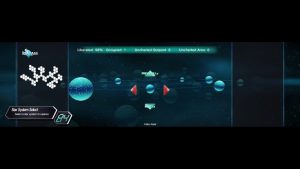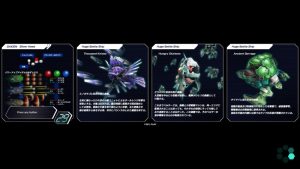Review | DariusBurst Chronicle Saviours
DariusBurst : Chronicle Saviours
Introduction
The Shmup craze is never one which seemed to exist in my hometown – our limited arcade was full of racing games, shooters, and ticket-spitting kinetic games. I faintly remember, in my primary school years, heading around a friend’s house and playing a brightly coloured, 16-bit shoot ’em up – I was completely rubbish at it. I remember the explosions, the chaos, and the damn-good music, but, I had grown up with adventure, platform and strategy games – this was hot-blooded action, a relfex driven explosion of arcade action. I still don’t know the name of that game.
 My next foray into the genre was through 1942, there’d been a Capcom collection released onto the PS1 which included several of the games – these were vertical, screen-climbing, shooters, my reflexes were a bit better now – as we’d gained a PC, and the PS1 had brought First Person Shooters to the console market in a big way. While I’d been playing what are now commonly known as ‘twin-stick shooters’ for years – we’d found Llamatron before Robotron, and had major fun – Shmups were still a greater challenge for me, the act of dodging the incoming projectiles, maintaining awareness of enemies, and trying to not stare too much at the background… but I was starting to get the hang of them, albeit by playing a title which had launched in arcades nearly 15 years earlier.
My next foray into the genre was through 1942, there’d been a Capcom collection released onto the PS1 which included several of the games – these were vertical, screen-climbing, shooters, my reflexes were a bit better now – as we’d gained a PC, and the PS1 had brought First Person Shooters to the console market in a big way. While I’d been playing what are now commonly known as ‘twin-stick shooters’ for years – we’d found Llamatron before Robotron, and had major fun – Shmups were still a greater challenge for me, the act of dodging the incoming projectiles, maintaining awareness of enemies, and trying to not stare too much at the background… but I was starting to get the hang of them, albeit by playing a title which had launched in arcades nearly 15 years earlier.
My local arcade shut in ’03, and there’s no sign of a successor opening. Trips into the capital, or nearby seaside-towns never see to turn up anything in the Shmup department either. This means that the only way to experience the classic titles, is the same way to experience the modern ones – through emulation, releases, or remasters.
The Darius Series

Darius, as a series, has always been fairly simple to explain. You pilot a small ship against hillariously overwhelming odds – as you fly from the left of an area to the right, dodging obstacles and bullets along the way. At the end of levels, you come up against gigantic mechanised versions of aquatic animals, shrimps, turtles, manta-rays. Your ship might be outnumbered, but aside from the bosses it’s not outgunned, each of the series’ crafts come with powerful secondary weapons.
The series first launched into Japanese arcades back in 1986, over the next thirty years it launched and relaunched multiple sequels and spin-offs, each building on the first’s reputation of unique bosses, cool music, and branching story path.
Dariusburst: Chronicles Saviour launched late last year onto Steam (with PS4 & Vita versions also launching) where it currently sits with a very nice batch of positive reviews, if of a somewhat limited amount.
In Review
Chronicles Saviour contains all of the content of the latest entry in the series, “Another Chronicle EX”, which I’ll refer to as AC going forward. It’s also got a new, exclusive mode called Chronicle Saviours, which… Hey! That’s the subtitle of the game! Which I’ll cover in depth later
As the first big ‘wow’ of the title goes, you can run the game over dual screens, in 32:9 ratio, which makes for some truly astounding ‘too much to take in’ moments – that and the sound blasting out over headphones is probably as close as you will get to the arcade edition without actually heading into the dangerous outside world.

AC mode takes you to another menu, one which contains the majority of the game’s modes. As you head into AC you are actually also assigning yourself to a ‘cabinet’, one of 128 which all of the game’s players are spread out over. This cabinet system comes into play when you play through the Chronicle Mode, a massive campaign in which players around the world unlock, and clear, missions as to save the game’s galaxy. There’s a mass of planets, and each one has a hilariously oversized hex grid, with each having altering affects to the challenge within. It makes for over 3000 levels, of which you’re almost guaranteed to play all of – it’s completely overwhelming.
As you make your way through Chronicle Mode you’ll work with other players to unlock that map, completing different combinations of levels and bosses, set against challenges which restrict ship load-out, pick-ups available, or even the amount of players required to partake. There’s several ships available throughout, but this is altered by the conditions of the varying levels.
On the subject of ships, the game has 9 different ships to choose from, from throughout the series, one of which is exclusive to the Chronicles Saviour Mode. Each ship handles about the same, but has different weapons types, and different special moves. For most of my time playing the other AC modes I used Gaiden, which projected a large black-hole which did massive recurring damage as the enemies flew through it. While features from the G series – capturing bosses as your minions – are absent from the game, you do have other popular features returning – like the ability to counter blast an enemy with your own laser as to cause massive reflected damage.

The other AC modes are Original and Original EX. These play out like the classic arcade titles, you select a starting system from three, on the left hand-side of the screen, and then at the end of a level you choose which way to progress through the three-stepped set of 12 levels. Difficulties alter as you move lower towards the grid, and for those that clear the Original mode, EX’s easiest outing is harder than the toughest of Original while featuring another 12 levels in the same format.
Chronicle Saviours is the exclusive, new mode, and it’s both a tribute to the series’ history, and the first time Darius has seen elements of a story featured in it. The mode has over 200 levels with increasing difficulty, with new levels only being unlocked through the completion of the last. The levels are placed along a timeline, one which also plays out the history of the titles alongside – meaning the first few levels use the first game’s ships, against the first game’s music, with the first game’s bosses.
As you play you are recommended a load out for each level – the game’s way of keeping the era progression in check – however your score earns you points with which you can start building up your own ship, that better suits your playstyle.

The mode is a really charming idea, and it’s also a very good way for new players to explore the sheer content of the long running series. I found that my playstyle improved with the default ship quite a bit after spending some time with the CS mode – but, then, Darius, like any other great twin-stick, or shmup game, seems to teach you habits and patterns just by having you play.
For anyone who already knows the Darius series, they don’t need to be told, but otherwise, it’s the bosses in the series that are truly iconic. They’re all themed after sea-dwelling creatures, but, obviously with the cybernetic, evil, laser-firing death robot twist that you’d expect from the series. In total there’s just over 40 bosses, with evil turtles, goldfish, lobsters and – my favorite – manta rays, among their number. Each boss has it’s own moves and manuevers that you’ll be forced to quickly pick up as you play through the game.
The price point is a massive elephant in the room, at time of writing, the game is £30, which is a whopper when compared to other Shmups. However, what should definitely be considered before you mentally bin the game is exactly what the gleaming positive reviews say – this game is massive, it’s got over 3000 in one mode, and 200 in the exclusive mode, this as well as the classic arcade mode available on two difficulties. Consider that sheer amount and also the fact that there’s a massive amount of high quality, bug-free gaming to be had.

Unlike the shmups I’ve grown to wiggle my eyebrows at and avoid, DariusBurst opts to have masses of enemies on screen, as opposed to masses of bullets. As well as this your ship can actually survive a few minor impacts, and the hit detection is bang on – when it does get a little bit more bullet hell in some boss fights, you can weave through ridiculous gaps with minimal fear of the game deciding you were a little too wide for the gap.
Aside from all the content, and the overall excellent production, there are a few niggling oddities to be found. A game with this many levels, this many bosses, and this many ships, should have a scenario or practice mode, where you could practice against certain levels, layouts or bosses. There’s a few navigation issues too, certain screens request that you press any button to proceed – this is perfectly as described – as you try to press ESC to navigate back a menu you simply proceed forward through the menus. It’s a bit frustrating having to quit back through a menu by advancing through another.

Finally, and this is a very minor complaint, but one definitely worth mentioning. All of the mission briefings are in Japanese. There’s amazing boss art and, clear as day, there’s characters which explain the enemies attacks and types, it’s just not been translated into any other language. This is a shame, as it will put new players on a back-foot during their first time against a boss – although, on the other hand, it does remind me of my days of playing grey-market imports of overseas titles.
If you’re a fan of Shmups, it’s something you’ve really got to put aside your worries about the price for, and even if you’re not too familiar with the game it’s still worth taking a gamble on – the amount of content, and the structure of the difficulty curve make it exceptionally easy to pick up and play. The four-player couch co-op is also another major reason to grab the game.
Comments are closed.